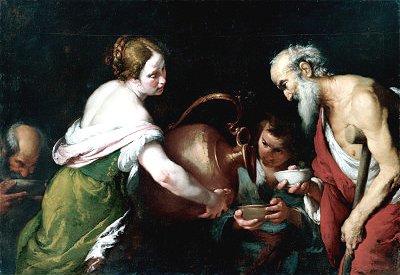 |
|
AN ACT OF MERCY
Bernardo Strozzi Italian
1581-1644
SN 634 Oil on Canvas About
1618-20
by Robert Anderson
ARTIST
Bernardo Strozzi was the leading Genoese painter of his period. He was
successful and prolific in both Genoa and Venice, painting portraits and allegorical and
genre scenes as well as religious works. The sensuous richness of his style was influenced
by Rubens but the air of refinement and tenderness recalls van Dyck. Around 1620 he moved
towards a more lively naturalism. In this he was influenced by Caravaggio whose style of
painting had been introduced to Genoa by his followers. |
In this period Strozzi also embarked on a career as a fresco painter but little of his
work has survived. He was by inclination an easel painter.
On his death Strozzi left many pupils and followers. He had a
considerable impact on painting in the first half of the 17th century which kept alive the
painterly tradition of the 16th century. His work is represented in many major galleries.
SUBJECT
The subject is one of the Seven Acts of Mercy, that of "Giving
Drink to the Thirsty". The Acts of Mercy are described in the New Testament, Matthew
25: 31-46. Food to the hungry, drink to the thirsty, shelter to the homeless, clothing to
the naked, and visits to the sick and those in prison were all to be acts of kindness
given to the needy by a Christian. As part of the teachings of Christ, they became a
popular themes in Baroque art after Caravaggio painted an altarpiece on the subject for a
Neopolitan church.
PAINTING
The painting depicts a young woman pouring water into bowls held by
three thirsty men - one old with a crutch, one midle age with a bald head and the third
quite young. It can be seen as an exmplary act of charity in the guise of a genre scene,
without presuming any specific religious content or as a demonstration of carrying out the
commands of Christ in this regard.
The infirmity of the old man is highlighted as are the face, shoulder
and arm of the young woman. At the time the picture was painted Strozzi was under the
influence of Caravaggio. Notice the way the woman's right elbow juts out beyond the plane
of the picture in true Baroque style. Strozzi was a bold colorist and in this painting the
intense red of the old man's robe plays well against the olive green of the woman's dress.
HISTORICAL CONTEXT
As opposed to Protestanism, which proclaimed that salvation was to be
gained by faith and faith alone, the Catholic Church continued to promote good works as a
way to assure a satisfactory after life. Baroque artists were in the forefront of the
Church's propaganda movement and therefore it is easily understood why they would make it
a popular subject in their art of the period. |